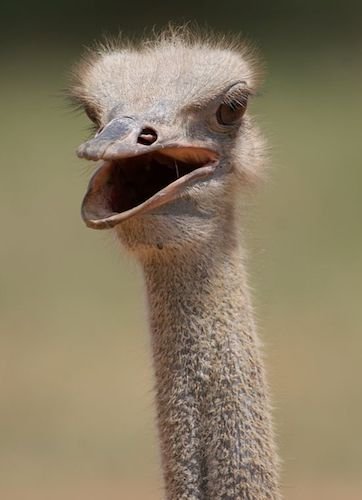Struthionidae – Ostriches

The Struthionidae is a family of huge flightless ratite birds which first appeared during the Eocene epoch. It is today represented by the sole living genus Struthio. (It also contains several extinct genera).
Traditionally the order Struthioniformes contain the world’s ratites, but recent genetic analysis has found that the group is not monophletyic, as it paraphyletic in respect to the tinamous.
Ostriches can weigh as much as 150K, reach more than two meters in height and can run at a sustained speed of 50KPH!
Molecular evidence indicates that the East African Rift has served as a geographic barrier to isolate the North African ostrich S. c. camelus, while ecological and behavioural differences have kept it genetically distinct from the neighbouring Masai ostrich S. c. massaicus. An examination of the mitochondrial DNA of Struthio taxa, including the extinct Arabian ostrich S. c. syriacus, has found that the Somali ostrich is phylogenetically the most distinct, appearing to have diverged from their common ancestor some 3.6 to 4.1 million years ago. Formerly considered just one species the IOC now recognises two species in this family, which are:
Common Ostrich Struthio camelus
Somali Ostrich Struthio molybdophanes
The Common Ostrich has three races, the nominate race camelus is mostly found in the west and south Sahara and Sahel; massaicus is found from southern Kenya to Tanzania and australis is found in southern Africa.
-
Common Ostrich Struthio camelus
IUCN Species StatusIUCN species profile... -
Somali Ostrich Struthio molybdophanes
Species AccountSound archive and distribution map...
-
Ostrich & Emu Links
WebpageThe ostrich is the world`s largest living bird. The ostrich is a flightless bird, but it can run up to speeds of 40 mph. It can sustained this speed up to 30 minutes. The bird is indigenous to Africa and is not an endangered species. The ostrich is the only bird that has two toes on each foot. An ostrich reaches its breeding maturity at about three years of age. An ostrich can live to be about 70 years old. They can weigh from 250 to 400 pounds and stand 6 to 8 feet tall. A hen can lay from 10 to 70 eggs each year. Each egg weighs about three to four pounds and is about 6 inches in diameter. The gestation period is 42 days. An ostrich will yield 70 to 100 pounds of meat, two to four pounds of feathers, and 12-15 square feet of leather. Ostrich do not put their heads in the sand. -
Somali Ostrich Added to List of Threatened Species
ArticleDid you know there are two species of ostrich? Don't worry if this is news to you—scientists didn't know that for sure either until this year, when the Somali ostrich (Struthio molybdophanes) of Ethiopia, Somalia, Djibouti and Kenya was declared a separate species from the common ostrich (S. camelus). Previously considered a subspecies, the Somali ostrich has now been added—along with 360 other newly discovered bird species—to the International Union for Conservation of Nature’s Red List of Threatened Species. The Red List update come from an assessment of the world's birds of prey, seabirds, water birds, owls and similar species (collectively known as nonpasserine birds, because all other birds come from the order Passeriformes) by the conservation organization BirdLife International...
